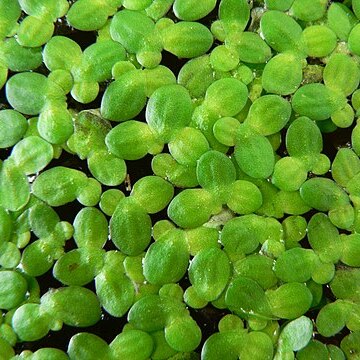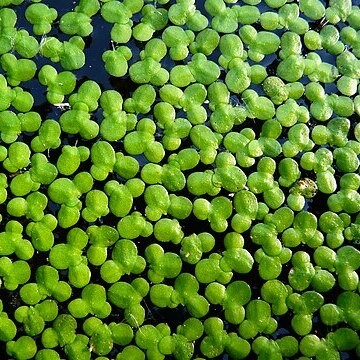Roots 1 per frond. Fronds floating or submersed, 1 or 2--20 or more, coherent in groups or forming chains, lanceolate-ovate, flat or gibbous, 1--15 mm, margins entire or denticulate, upper surfaces sometimes with small conic papillae along veins (especially at node and near apex); air spaces in tissue; reproductive pouches 2, lateral, at base from which daughter fronds and flowers originate, triangular; veins 1--5(--7), originating from point in proximal part of frond (node) or if more than 3 veins present, outer ones sometimes branching distally from inner ones; scale at base of frond absent; anthocyanins sometimes present; pigment cells absent (red pigmentation present in some species); turions absent (sometimes present in L. turionifera). Flowers 1(--2) per frond, surrounded by small utricular, membranous scale; stamens 2, 4-locular. Seeds 1--5, longitudinally ribbed. x = 10, 21, 22..
Fronds free floating on water surface or submersed, 1 to many individual fronds coherent together, green on upper surface, sometimes red on lower surface, symmetric or asymmetric in shape, flat or sometimes gibbous on lower surface; 2 lateral pouches reproducing daughter fronds and flower present at base, bases of pouches not surrounded by a scale; veins 1-5(-7), splitting from node toward apex. Pigment cells absent. Root 1, sometimes dropped off or lacking (Lemna trisulca), surrounded by a short tubular sheath at base and enclosed by a cap at apex. Daughter fronds connected to mother frond by a thin white stipe or a green stalk (L. trisulca). Flower surrounded by small, utricular, membranous scale; stamens 2, 4-locular. Seeds 1-5, longitudinally ribbed.
Aquatics, submerged or more usually floating in great numbers; individual thalli cohering. Thalli oblong to ovate, ± asymmetrical, thin or spongy. Daughter thallus budding from lateral pocket. Root solitary, devoid of hairs,shortly sheathed near point of origin; sheath simple or laterally winged; apex of root sheathed by a conspicuous root-cap, tip acute or obtuse. Flowering erratic; floral pocket lateral with spathe enclosing 2 staminate and 1 pistillate flowers. Fruit (l–6)-seeded. Seed usually ribbed.
Thallus flat to strongly convex beneath, variously rotund, ovate, obovate, oblong, or stipitate, with 1–5 obscure nerves from a nodal point near the base, or nerveless; root 1, opposite the nodal point, without vascular tissue, surrounded by an inconspicuous short sheath at base; reproduction as in Spirodela; ovules 1–6; seed longitudinally ribbed and transversely striate, or smooth. 10, cosmop.
Fronds attached by the basal margins, each bearing a solitary root; reproductive pouches opening as clefts in either margin of the basal portion of the frond. Spadix of 1 pistillate and 2 staminate flowers, surrounded by an inconspicuous spathe.
Fronds floating on or below water surface, 1–many cohering together; margins entire or denticulate; nerves 1–5 (–7); frond base without a scale. Turions mostly absent. Roots 1 per frond.


